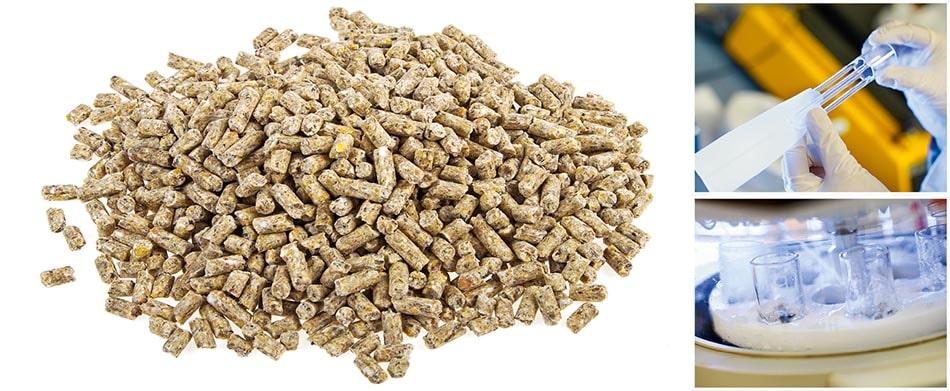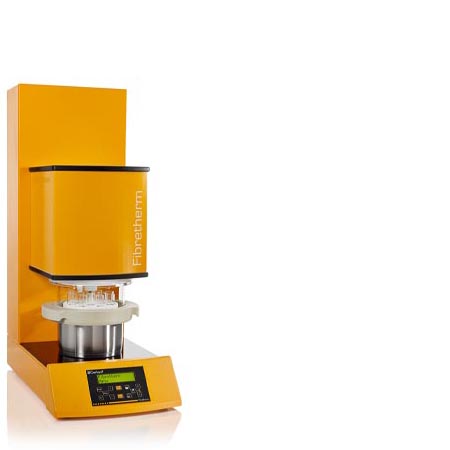Introduction
The determination of the crude fibre content is an important analysis in feed analysis. Besides crude protein (determination acc. to Kjeldahl) and crude fat (determination acc. to Weibull-Stoldt), crude fibre is an essential parameter of animal feed and is determined as part of the Weender feed analysis. The crude fibre content describes the plant cell wall components (including cellulose, hemicellulose, lignin), which are usually not or barely digestible, and thus the portion of the feed that is not energetically usable by the animals. However, the analysis is relevant for feed manufacturers, as they are not only obliged to label the crude fibre content in the feed, but a certain amount of crude fibre in the feed is also beneficial for animal health. Crude fibre stimulates digestion and also encourages the production of important intestinal bacteria. The amount of crude fibre in the animal feed thus basically depends on the purpose of the feed, e.g. dog food that stimulates digestion needs a slightly higher crude fibre content. With the application "Crude fiber determination in animal feed" and the automatic fibre extractor FIBRETHERM, feed laboratories can determine the crude fibre content reliably and standardised.
Crude fiber analysis in feed
Sample preparation:
The sample is comminuted to a particle size of 1 mm. This comminution is carried out, for example, with a high-speed rotor mill. Excessively high temperatures during grinding can result in separation of the sample and clogging of the sieves in the mill.
- App note: It is important to always work with the same particle size, because the smaller the particle size, the lower the recovery.
Sample weighing:
First, the empty weight of the FibreBag is measured. Since the FibreBags are usually mass-stable, it is not necessary to pre-dry them in the drying oven. The glass spacers are inserted into the FibreBags and positioned in the quartzcrucible to weigh the sample. Approximately 1 g of the sample is weighed directly into the FibreBags to the nearest 1 mg.
Degreasing:
After weighing the samples into the FibreBags, the samples are degreased using the degreasing module before the start of the FIBRETHERM run (3x with 100 ml petroleum ether 40/60 each). After degreasing, the samples are dried in a fume hood until the petroleum ether has completely evaporated.
- App note: Samples containing less than 5 % fat do not need to be degreased. Samples containing 5 - 10 % fat can be degreased and samples containing more than 10 % fat must be degreased. Degreasing also prevents the formation of foam.
Digestion:
The samples, including the glass spacer, are inserted into the sample carousel of the FIBRETHERM and the crude fiber method is started. The treatment of the samples with sulfuric acid and potassium or sodium hydroxide is carried out completely automatically by the instrument, whereby boiling times are kept exactly and in a reproducible manner.
- App note: Between and after treatment of the samples with the detergents, the samples and the digestion vessel are rinsed with water.
Drying:
The samples are removed from the carousel and the glass spacers with the FibreBags are transferred to the incineration crucible and dried in the drying oven at 105 °C for at least 4 hours or overnight. The crucibles with the FibreBags are then placed in the desiccator until cooled to room temperature and weighed.
- App note: The incineration module simplifies sample transfer, but is not absolutely necessary. Alternatively, common beakers can also be used for drying and incineration the samples.
Incineration:
The dried samples are then incinerated in a muffle furnace at 500 °C +/-25 °C for at least 4 hours. The vapors generated during the incineration process are harmless. After the incineration, the crucibles are cooled in a drying oven at 105 °C for about 30 minutes and then placed in the desiccator until cooled to room temperature. The crucible is then weighed.
- App note: By weighing the difference between the dried and incinerated sample, the fiber content of the sample can be calculated.


